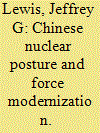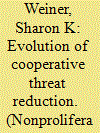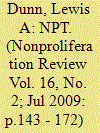|
|
|
Sort Order |
|
|
|
Items / Page
|
|
|
|
|
|
|
| Srl | Item |
| 1 |
ID:
089070


|
|
|
|
|
| Publication |
2009.
|
| Summary/Abstract |
Claims that China is the only nuclear power currently expanding its arsenal fail to take into account the technical, historical, and bureaucratic realities that shaped China's nuclear posture and drive its ongoing modernization. China's strategic modernization is largely a process of deploying new delivery systems, not designing new nuclear warheads; the majority of its new missiles are conventionally armed. Today, China maintains the smallest operationally deployed nuclear force of any of the legally recognized nuclear weapon states, operates under a no-first-use pledge, and keeps its warheads off alert. The modernization of China's delivery systems is the culmination of a decades-long plan to acquire the same capabilities deployed by the other nuclear powers. U.S. concerns about this modernization focus too much on deterring a deliberate Chinese attack and ignore the risk that modernized U.S. and Chinese forces could interact in unexpected ways during a crisis, creating uncontrollable escalatory pressures. To manage this risk, Washington should assure Chinese leaders that it does not seek to deny China's deterrent, in exchange for some understanding that China will not seek numerical parity with U.S. nuclear forces.
|
|
|
|
|
|
|
|
|
|
|
|
|
|
|
|
| 2 |
ID:
089071


|
|
|
|
|
| Publication |
2009.
|
| Summary/Abstract |
Since its beginning in 1991, Cooperative Threat Reduction (CTR) has grown to include a host of programs aimed at securing former Soviet weapons of mass destruction, weapons-relevant materials, and expertise. Multiple U.S. and Russian agencies are involved, and some programs have expanded beyond the former Soviet Union. CTR has demonstrated considerable success, but much work remains. Moreover, it is likely that the CTR agenda will be re-evaluated and refocused owing to reviews by the Obama administration, increasingly strained relations with Russia, and the global economic crisis. Any such analysis, however, should proceed from a clear understanding of both CTR's performance to date as well as lessons learned from this experience. This article provides a start by summarizing progress toward CTR's main goals, outlining the scope of remaining tasks, and looking at persistent problems in both the United States and Russia. In particular, CTR's future progress depends upon forging a new U.S. domestic consensus on the national security benefits of CTR, encouraging Russia to become a true partner in CTR activities, and improving interagency leadership and coordination. In turn, these improvements can help resolve emerging questions about the cooperative nonproliferation agenda as it expands beyond the former Soviet Union.
|
|
|
|
|
|
|
|
|
|
|
|
|
|
|
|
| 3 |
ID:
089069


|
|
|
|
|
| Publication |
2009.
|
| Summary/Abstract |
How do we assess the health of international regimes? Many analysts have insisted recently that the nuclear nonproliferation regime is in urgent need of repair or that it should even be discarded because of its supposed ineffectiveness. However, it is essential that statements about the regime being in crisis be scrutinized for veracity and utility. While the spread of nuclear weapons poses an undeniable and serious threat to international security, a mistaken crisis mentality with respect to the regime could lead to rash attempts to alter it in unnecessary or ineffective ways or, at worst, to discard it completely. This paper returns to a theoretical framework that differentiates regimes, across both issue areas and time, to provide a more specified evaluation of regime health. By disaggregating the nuclear nonproliferation regime and assessing the individual and interactive health of multiple dimensions, a number of dimension-specific, regime-strengthening policy recommendations emerge.
|
|
|
|
|
|
|
|
|
|
|
|
|
|
|
|
| 4 |
ID:
089068


|
|
|
|
|
| Publication |
2009.
|
| Summary/Abstract |
This article assesses the successes and failures of the Treaty on the Non-Proliferation of Nuclear Weapons (NPT) since its creation in 1968 by developing and applying a set of "metrics" to each of the NPT's substantive articles as well as to its withdrawal provisions. In light of this analysis, the article also puts forward some specific proposals for strengthening the NPT and its implementation, with a view to the debate and decisions at the upcoming 2010 NPT Review Conference. A concluding section turns explicitly to the 2010 NPT Review Conference and proposes pursuit of agreement on three NPT Action Plans: one for nonproliferation, one for peaceful uses, and one for nuclear disarmament. Combining vision and practicable steps, these Action Plans would set out a roadmap for action between the 2010 and the 2015 NPT Review Conferences. They could provide a foundation for substantive exchanges-in this case, on progress toward their implementation-during the preparations for the 2015 conference.
|
|
|
|
|
|
|
|
|
|
|
|
|
|
|
|
| 5 |
ID:
089072


|
|
|
|
|
| Publication |
2009.
|
| Summary/Abstract |
By the end of 2008, ninety-five states had signed the Convention on Cluster Munitions, which bans the development, production, acquisition, stockpiling, and transfer of cluster munitions; imposes significant obligations for the clearance of unexploded cluster munition remnants; and elaborates novel requirements for so-called victim assistance. This article examines this agreement and the process that lead up to it in terms of the precedents it sets for future arguments about weapon technologies and the regulation of armed conflict. Particularly noteworthy was the process for determining what counts as a "cluster munition" under the convention. The definition structure transformed the argument from considerations of what types should be prohibited to demanding justifications for what should be allowed. In other words, rather than the burden of proof resting with those seeking a ban, the presumption became that exclusions from prohibition had to be argued in by proponents of specific submunition-based weapons. This approach contrasts with the manner in which the burden of proof regarding cluster munitions has been handled in international humanitarian law.
|
|
|
|
|
|
|
|
|
|
|
|
|
|
|
|
|
|
|
|
|